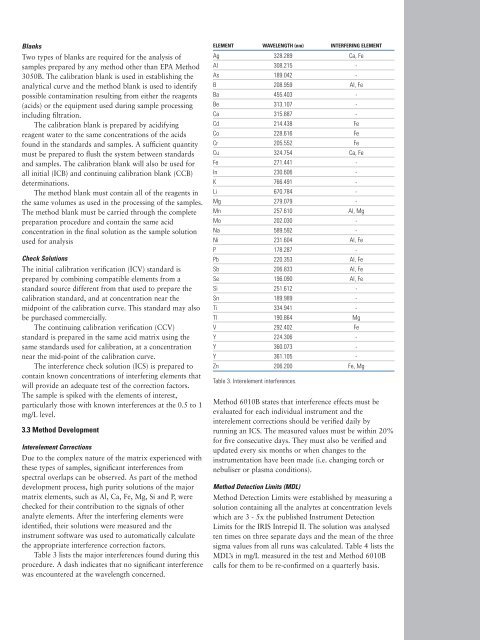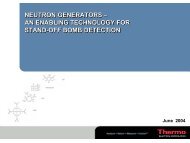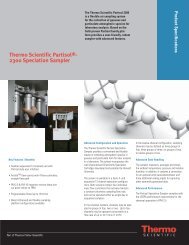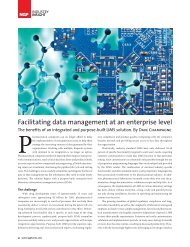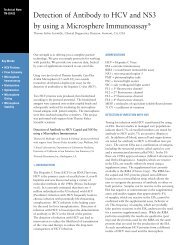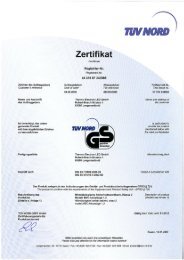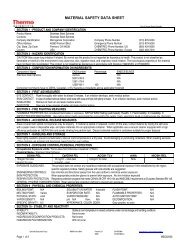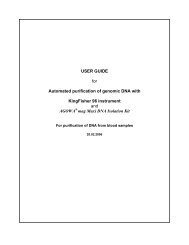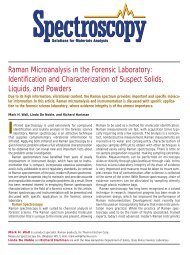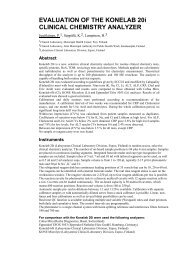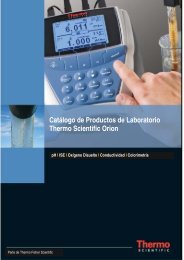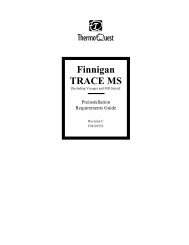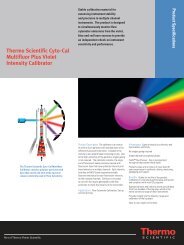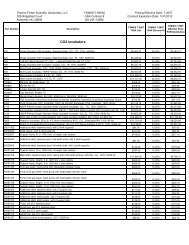8 Hour Stability
8 Hour Stability
8 Hour Stability
Create successful ePaper yourself
Turn your PDF publications into a flip-book with our unique Google optimized e-Paper software.
Blanks<br />
Two types of blanks are required for the analysis of<br />
samples prepared by any method other than EPA Method<br />
3050B. The calibration blank is used in establishing the<br />
analytical curve and the method blank is used to identify<br />
possible contamination resulting from either the reagents<br />
(acids) or the equipment used during sample processing<br />
including filtration.<br />
The calibration blank is prepared by acidifying<br />
reagent water to the same concentrations of the acids<br />
found in the standards and samples. A sufficient quantity<br />
must be prepared to flush the system between standards<br />
and samples. The calibration blank will also be used for<br />
all initial (ICB) and continuing calibration blank (CCB)<br />
determinations.<br />
The method blank must contain all of the reagents in<br />
the same volumes as used in the processing of the samples.<br />
The method blank must be carried through the complete<br />
preparation procedure and contain the same acid<br />
concentration in the final solution as the sample solution<br />
used for analysis<br />
Check Solutions<br />
The initial calibration verification (ICV) standard is<br />
prepared by combining compatible elements from a<br />
standard source different from that used to prepare the<br />
calibration standard, and at concentration near the<br />
midpoint of the calibration curve. This standard may also<br />
be purchased commercially.<br />
The continuing calibration verification (CCV)<br />
standard is prepared in the same acid matrix using the<br />
same standards used for calibration, at a concentration<br />
near the mid-point of the calibration curve.<br />
The interference check solution (ICS) is prepared to<br />
contain known concentrations of interfering elements that<br />
will provide an adequate test of the correction factors.<br />
The sample is spiked with the elements of interest,<br />
particularly those with known interferences at the 0.5 to 1<br />
mg/L level.<br />
3.3 Method Development<br />
Interelement Corrections<br />
Due to the complex nature of the matrix experienced with<br />
these types of samples, significant interferences from<br />
spectral overlaps can be observed. As part of the method<br />
development process, high purity solutions of the major<br />
matrix elements, such as Al, Ca, Fe, Mg, Si and P, were<br />
checked for their contribution to the signals of other<br />
analyte elements. After the interfering elements were<br />
identified, their solutions were measured and the<br />
instrument software was used to automatically calculate<br />
the appropriate interference correction factors.<br />
Table 3 lists the major interferences found during this<br />
procedure. A dash indicates that no significant interference<br />
was encountered at the wavelength concerned.<br />
ELEMENT WAVELENGTH (nm) INTERFERING ELEMENT<br />
Ag 328.289 Ca, Fe<br />
Al 308.215 -<br />
As 189.042 -<br />
B 208.959 Al, Fe<br />
Ba 455.403 -<br />
Be 313.107 -<br />
Ca 315.887 -<br />
Cd 214.438 Fe<br />
Co 228.616 Fe<br />
Cr 205.552 Fe<br />
Cu 324.754 Ca, Fe<br />
Fe 271.441 -<br />
In 230.606 -<br />
K 766.491 -<br />
Li 670.784 -<br />
Mg 279.079 -<br />
Mn 257.610 Al, Mg<br />
Mo 202.030 -<br />
Na 589.592 -<br />
Ni 231.604 Al, Fe<br />
P 178.287 -<br />
Pb 220.353 Al, Fe<br />
Sb 206.833 Al, Fe<br />
Se 196.090 Al, Fe<br />
Si 251.612 -<br />
Sn 189.989 -<br />
Ti 334.941 -<br />
Tl 190.864 Mg<br />
V 292.402 Fe<br />
Y 224.306 -<br />
Y 360.073 -<br />
Y 361.105 -<br />
Zn 206.200 Fe, Mg<br />
Table 3. Interelement interferences.<br />
Method 6010B states that interference effects must be<br />
evaluated for each individual instrument and the<br />
interelement corrections should be verified daily by<br />
running an ICS. The measured values must be within 20%<br />
for five consecutive days. They must also be verified and<br />
updated every six months or when changes to the<br />
instrumentation have been made (i.e. changing torch or<br />
nebuliser or plasma conditions).<br />
Method Detection Limits (MDL)<br />
Method Detection Limits were established by measuring a<br />
solution containing all the analytes at concentration levels<br />
which are 3 - 5x the published Instrument Detection<br />
Limits for the IRIS Intrepid II. The solution was analysed<br />
ten times on three separate days and the mean of the three<br />
sigma values from all runs was calculated. Table 4 lists the<br />
MDL’s in mg/L measured in the test and Method 6010B<br />
calls for them to be re-confirmed on a quarterly basis.


